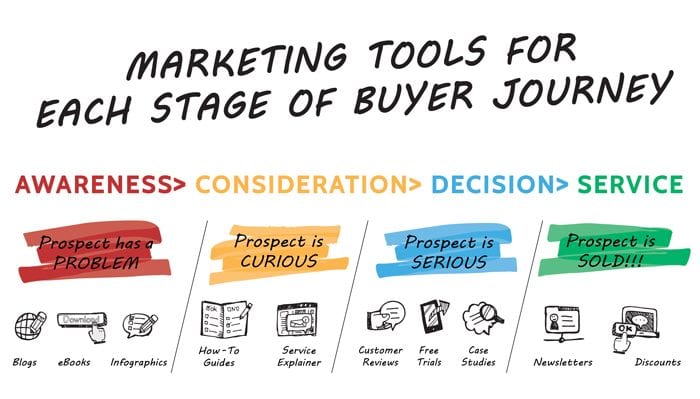 Before a prospect becomes a customer, they’ll have to go through their own journey to get there. The buyer’s journey typically consists of four stages – awareness, consideration, decision, and service – with each one playing an essential role in moving them along to the next phase.
Before a prospect becomes a customer, they’ll have to go through their own journey to get there. The buyer’s journey typically consists of four stages – awareness, consideration, decision, and service – with each one playing an essential role in moving them along to the next phase.
It’s important for businesses to tailor their marketing strategies to every one of these stages in order to help their audience find solutions to their problems, and ultimately become a client.
Use this guide through the buyer’s journey to better understand each stage and get tips on how to market for them all:

Stage 1: Awareness
The awareness stage marks the very beginning of the buyer’s journey, as a prospect is just starting to recognize they have a problem that needs to be solved. At this point, a potential buyer will probably be doing a lot of research on search engines to better understand their business concerns.
Awareness Stage Marketing Strategies:
You’ll want to have plenty of educational resources available on your site that explain various customer pain points, both in-depth and from a beginner’s standpoint. Blog posts, infographics, and ebooks are all notable content formats for this purpose.
Another critical aspect of marketing to people in the awareness stage is your SEO strategy. Using the right keywords and ranking high on SERPs will help prospects land on your site so they can use your content to inform themselves on their problems and move further along in the buyer’s journey.
Stage 2: Consideration
Once a prospect has fully grasped the nature of their business concern, they’ll naturally start to look for a solution. Research is still key in the consideration stage, as there are likely various ways a prospect can resolve their challenges, meaning they will be exploring what options are out there and which ones would work best for their company.
Consideration Stage Marketing Strategies:
Content will be a big player in marketing to prospects in the consideration stage, but the nature of your resources will differ from those tailored to people in the awareness stage. You should go a step further in your information by delving into the solutions to your audience’s problems. Useful content types for the consideration stage may include how-to guides and explainers of different services and how they can resolve a particular challenge.
Stage 3: Decision
With plenty of prior research on their side, prospects in the decision stage now fully understand their pain points and know what products or services they need that will solve their problems. At this time, a potential buyer will go through the process of choosing what company to go with for their business’s needs.
Decision Stage Marketing Strategies:
As prospects in the decision stage will likely be comparing various companies and their service offerings, you’ll need to prove your business’s value now more than ever. Including content such as customer reviews and testimonials as well as case studies, is a great way to showcase the success that your products or services bring.
In terms of content offers, free trials and complimentary consultations show your expertise without customers having to commit to a purchase. Once they have experienced the value of your services for themselves, prospects should be happy to go into business with you.
Stage 4: Service
While the old version of the buyer’s journey was more of a funnel ending at the decision stage, good marketers now view the buyer’s journey as a continuous cycle. You shouldn’t discontinue your marketing efforts once someone becomes a customer. If you’ve done all that work throughout the other points of the buyer’s journey to prove the value of your business, you’ll need to follow through on that promise. Providing the best service possible to your clients is essential to keeping them happy, resulting in better customer retention rates and the opportunity for an upsell.
Service Stage Marketing Strategies:
You’ll, of course, want to delight customers in every experience they have with your company, but there are also ways you can market to them during this time. Consider creating content that both entertains and educates, such as a monthly newsletter. Special offers such as discounted services or products are another great marketing tactic that shows appreciation for your client base.
No matter what phase of the buyer’s journey a prospect lies in, it’s essential that you have individual marketing strategies and supplemental content set up for each one. When you tailor your campaigns to the various stages your audience goes through, and you can meet each prospect’s individual needs and move them along to the next step.
HeadsUp is an Inbound marketing agency that utilizes content marketing and search engine optimization to bring quality leads to our clients. Contact us today to learn more about how we can grow your company!

